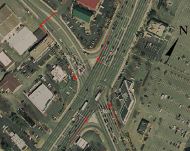10/29/2010
Virginia: Red Light Camera Installed at Accident-Free LocationAlbemarle County, Virginia installs red light camera at location with no angle collisions.

Albemarle County, Virginia plans this week to install its first red light camera system, ostensibly to reduce accidents caused by red light running. County documents show that at one of the two intersection approaches selected, there has not been a single accident caused by red light running in the past three years.
The county applied to the Virginia Department of Transportation (VDOT) earlier this year for permission to allow Redflex Traffic Systems of Australia to install and operate a pair of cameras at the intersection of US 29 and Rio Road. The east bound approach at Rio Road had no reported angle collisions caused by red light running violations between 2006 and 2009, according to county records. The other monitored approach, US 29 southbound, did have related crashes. The annual crash total for the type of accidents that the photo enforcement system might address is 1.8 per year.
While not having a red light running crash problem, the location reported 68 percent of its accidents (121 out of 177 in three years) were rear end collisions. A 2007 VDOT report concluded that use of red light cameras increased the number of rear end collisions by an average of 42 percent in Northern Virginia. That means if the system worked perfectly, there would be 1.8 fewer angle collisions, but 17 more rear end collisions each year.
"We acknowledge VDOT's comment that accidents most commonly associated with red light running are angle crashes and as such traffic signal enforcement may not help to reduce the majority of the crashes at this particular intersection; however, this is only one of the factors to be considered in the evaluation," the county's application admitted. "As provided in the sections that follow, our assessment and conclusions also factor in the violation volumes."
The two selected approaches proved to be the most lucrative for citation issuance. The intersection is one of the busiest in the area with an average of 71,549 vehicles -- mostly non-residents -- passing through each day. During the test, the system would have generated $7,600 worth of tickets in a 12-hour period -- about $5.5 million per year if the violation rate held constant.
"Both of these approaches pose a threat to the safety of the motorists, bicyclists, and pedestrians who use this densely developed corridor now and in the future," the county asserted.
The data show in three years, there were zero bicycle accidents reported and a single pedestrian incident. The report also lists yellow signal timing for the intersections that may prove to be too short for the conditions. At Rio Road, the yellow lasts 4.0 seconds for traffic facing a speed limit of 35 MPH. At US-29, however, the speed limit is 10 MPH faster and the intersection requires more time to traverse because it is 60 feet longer. Longer yellows are needed when speeds are faster and distances are greater, but US-29 is set at just 4.0 seconds, below even the short timings recommended by the Institute of Transportation Engineers guidelines.
A copy of the application is available in a 160k PDF file at the source link below.


